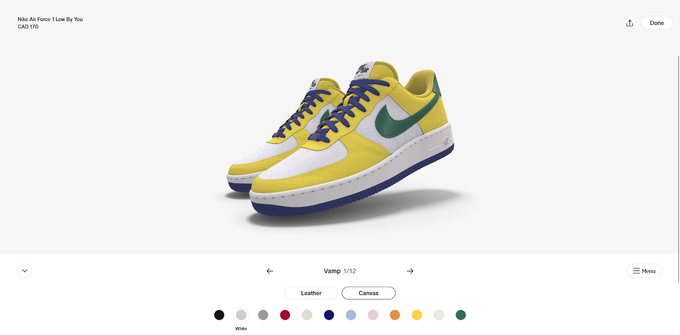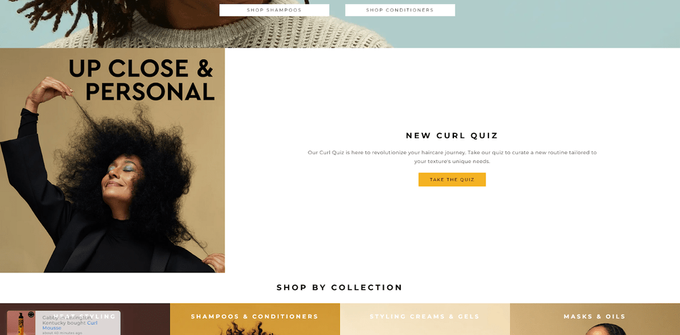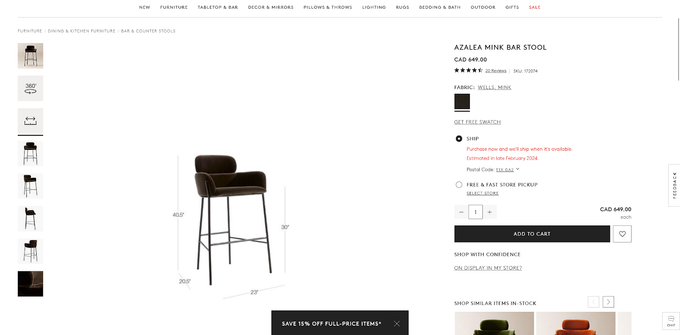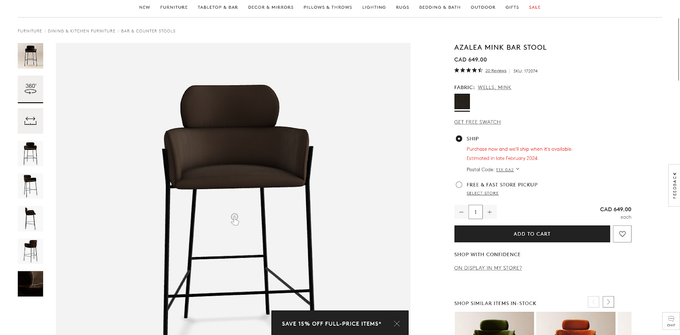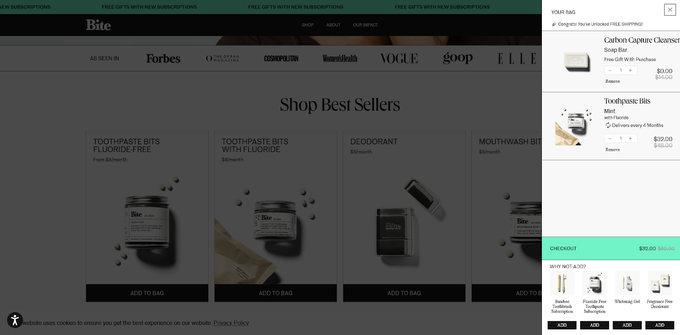7 Inspiring Digital Merchandising Examples to Emulate
Customization and personalization through online merchandising are no longer just for Nike and Apple—small eCommerce stores can offer tailored experiences, too.
Updated December 12, 2025

Shopping online is now the norm, meaning that brands have to keep evolving to meet rising customer expectations. Today's shoppers demand immersive digital experiences that mimic the real world, and implementing innovative merchandising strategies is crucial for eCommerce success.
This article explores 5 examples of digital visual merchandising done right, from customization to upsells, all of which can help you increase conversions.
» Not sure where to start? Let our merchandising solutions help
Meet the Expert
Jameela Ghann is an eCommerce and marketing expert with over 10 years of experience. Apart from running her own successful online store, Alora Boutique, she's the marketing manager of Fera.ai.
What Is Digital Merchandising?
Digital eCommerce merchandising refers to creating and managing product displays and promotions on digital platforms such as websites, mobile apps, and social media.
Put simply, digital merchandising for eCommerce is everything that goes into the way you display products on your website. To convert and retain customers, eCommerce brands must craft compelling digital shopping experiences for customers. This means using engaging visuals, interactive elements, and innovative digital merchandising tools that inform, excite, and assist customers.
» Stuck? Start with these engagement-building visual merchandising techniques
🔍Key Elements of Online Merchandising
Design
eCommerce is an inherently visual method of shopping, and customers are unlikely to purchase products that they don't think are visually appealing. This aesthetic principle should shine throughout the rest of your website as well, from leveraging color psychology to streamlining the navigation experience. All of this should be in an effort to strengthen your brand identity.
» Learn how to customize your eCommerce navigation experience
Product Discovery
The way you display products is also an essential aspect of your digital merchandising strategy. This could include using product tags and filters to help users discover products correctly, prioritizing best sellers over others to match consumer interest, or using collections to prevent customers from feeling overwhelmed.
» Make sure you understand the difference between product search vs. product discovery
Personalization
From personalized product recommendations to dynamic pricing, customers want to feel like the shopping experience is tailored to their specifications and needs. Recent personalization statistics suggest that customers want to feel that personal connection and are more likely to make purchases when faced with personalized recommendations.
Optimization
There are many elements that should be optimized on your eCommerce store, such as fast loading times through optimized images and ensuring that your store is optimized for your mobile audience.
» Here are some key strategies for mobile eCommerce
7 Digital Merchandising Examples
1. Personalized Shopping
In recent years, customers have increasingly valued unique and personalized products tailored to their preferences, enough to influence their buying decisions. To cater to this desire, some innovative brands have introduced customization features allowing customers to put their creative twist on products.
» New to personalization? Start with these eCommerce personalization strategies and platforms
Example: Nike's Custom Shoe Design Experience
Nike introduced a robust customization feature that empowers customers to design their own one-of-a-kind shoes, tapping into the rising customer demand for personalized products that feel unique to them.
Key elements of Nike's successful approach include:
- An interactive tool for designing shoes made customization easy. Users can add colors and patterns seamlessly.
- Customers could visualize their designs in an advanced 3D preview, setting proper expectations before ordering.
- Customization increased engagement and loyalty among Nike members, enhancing community feeling.
- Production logistics and maintaining a user-friendly interface posed challenges that Nike overcame through iteration.
» Here are some other ways to personalize your store
Smaller brands can also allow customization through apps like Product Options Customizer for Shopify. Overall, personalization offers an engaging experience that satisfies customer cravings for uniqueness.
» Consider leveraging personalized pricing to boost revenue
2. Product Recommendations
Finding the right products that fit specific needs is crucial for customer satisfaction, but can prove difficult with the overwhelming choices online.
» Own a fashion and beauty store? Here are some tips for visual merchandising in fashion eCommerce
Example: Pattern Beauty's Hair Quiz
Pattern Beauty's hair quiz aims to determine a customer's hair type and the best treatment plan for them to make personalized product recommendations for each individual.
Key details of their approach include:
- The same personalized advice a hairdresser would give, but with the convenience of home.
- Easy and enjoyable for the customer to take and understand.
- After completing the quiz, product suggestions are displayed in a clean, navigable section.
- This tailored approach is expected to increase sales and email sign-ups.
- Most importantly, customers get a custom consultation that improves satisfaction.
» Here's how personalized recommendations boost AOV
Product quizzes like this enable eCommerce brands to provide personalized algorithmic recommendations that mimic the tailored guidance of in-person shopping experiences. Typeform is an affordable tool that e-commerce owners can use to offer quizzes.
3. Streamlined Product Collections
Nesting related products together under broader website collections is a great strategy for streamlining the shopping and navigation experience. Customers have an easier time finding the products they need while search engines like Google can better understand the industry and type of products found in your store, boosting your SEO efforts.
Additionally, don't forget to leverage the power of product filters to further enhance the efficacy of your collections.
» Make sure you understand the difference between collections and categories
Example: Amazon
This is especially beneficial for eCommerce stores that sell a variety of products, such as Amazon who have easily understandable collections that house more refined sub-collections. For example, their homepage lists popular PCs and accessories under a single large section that can be expanded by clicking "see more", or refined even further into desktops, laptops, hard drives, and accessories, depending on what each customer is specifically searching for.
» Boost your store's navigation by implementing search within Shopify collections
4. Augmented Reality (AR) Technology
When buying furniture or decor online, customers are often deterred by the inability to see items in their own space before purchasing. AR technology bridges this gap by allowing virtual visualization.
Example: Crate and Barrel
Crate and Barrel reduces furniture shopping uncertainty with an AR feature that lets customers visualize products in their homes, giving online shoppers a spatial understanding similar to viewing furniture in a physical showroom.
Important aspects of their approach include:
- Realistic 3D models of products to give customers a life-like preview through AR.
- Direct AR integration on the product website makes visualization simple and convenient.
- Decreased returns and improved satisfaction by setting proper expectations.
» Let AI handle your eCommerce optimization
AR technology like this gives online customers an enhanced spatial understanding that simplifies purchase decisions, leading to more realistic expectations and decreased dissatisfaction.
5. 360-Degree Product Views
When shopping online, customers lack the ability to view products from all physical angles. Only seeing images from certain perspectives can make it hard to fully understand a product before purchasing.
360-degree product photography solves this by allowing customers to digitally view items from all angles.
» Discover how visual merchandising has evolved
Crate and Barrel also uses 360-degree product views like this:
Benefits include:
- Customers gain a more comprehensive visual sense of a product's details.
- Advanced rendering makes smooth 360-degree interaction easy even on mobile.
- Seeing a product fully gives customers greater confidence before purchasing.
» Don't forget to boost digital visual merchandising with visual search
360-degree views mimic the real-world ability to examine a physical product from all sides, providing the dynamic visual experience customers expect when shopping online.
6. Product Bundles
Product bundles involve grouping multiple products together and selling them as a bundle with a higher overall cost but lower cost-per-item, offering numerous benefits for customers and merchants:
- Perceived value: Since customers receive multiple products for a single purchase, the perceived value they receive is much higher, enticing them to spend more to maximize savings and boost the average order value.
- Push slow movers: If there are products on your store that don't sell as well as the others, consider bundling them with your bestsellers at a reduced cost to keep your stock moving without hurting your revenue.
- Seasonal deals: You can also consider bundling related products seasonally to create a sense of urgency and relevance to your target audience.
- Personalization: Another great product bundle tactic involves letting your customers take charge of their own purchases by creating custom bundles. For example, allowing fashion customers to make their own shoe bundles by choosing any 3 from a greater collection.
Example: Sephora
Sephora makes use of limited edition, time-sensitive product bundles with smaller-sized sample products that allow customers to try out a variety of items to decide which one best suits them. The bundles even come with extra makeup brushes to enhance the perceived value.
» Learn more: Our eCommerce product bundling guide
7. Cart Upsells
Once customers are ready to checkout, brands have a prime opportunity to suggest relevant complementary products. Cart upsells seize this moment through personalized product recommendations.
» Know the difference between cross-selling and upselling?
Example: Bite Beauty
Bite Beauty (now liplab.com) implemented a simple yet effective "Why Not Add?" upsell feature, increasing order values by suggesting related products commonly purchased together and suggesting recommendations tailored to what is already in the cart.
When you feature cart upsell technology in your store, offer personalized add-ons at checkout to enhance the shopping experience and boost order values.
» Learn more: The best eCommerce upsell tactics
Benefits of Digital E-Merchandising
- Improved customer experience: Effective online merchandising converts visitors into buyers more effectively through engaging content while providing a better customer experience that keeps shoppers coming back. All of this boosts your average order value and total sales.
- Better SEO: Great eCommerce merchandising not only attracts more website traffic by making products stand out but also helps product discovery by helping search engines understand your store and the kind of products that can be found there.
- Competitive advantage: Innovative features that are kept up to date through competitor analysis and pricing ensure that you always maintain an advantage over your competitors.
- Better inventory management: Strategic placement of products enhances your understanding of your own store, improving demand forecasting and helping you avoid stockouts and overstocking.
- Stronger brand awareness and loyalty: Consistent web merchandising helps differentiate your brand from the competition and create a cohesive experience across platforms. This, in turn, builds customer loyalty.
» Create an appealing and engaging shopping experience with visual merchandising
Preparing for the Future of Digital Merchandising
Automated digital visual merchandising will likely become more immersive and personalized through innovations like AI visual search and expanded AR capabilities.
Brands should prepare by:
- Investing in understanding and integrating emerging technologies.
- Focusing on seamless, engaging online experiences.
- Staying updated on digital merchandising trends.
As retailers invest in emerging technologies to enhance the digital shopping experience, consider AI-powered technologies to provide personalized, seamless, and engaging online experiences.
» Need help enhancing your site? Book a demo with us to start benefitting form our eCommerce technologies


